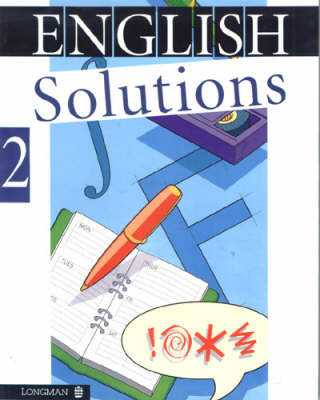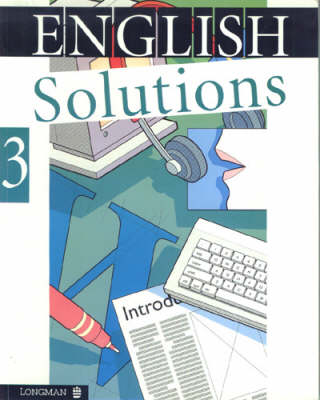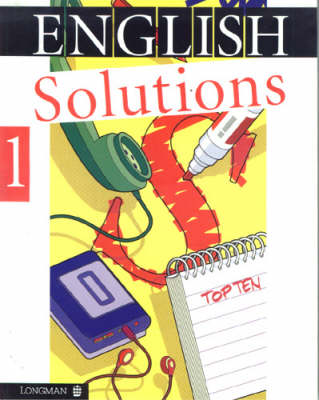English solutions
6 total works
"English Solutions" is a course for Key Stages 3 and 4 of the English Curriculum. It provides a language framework and a broad range of literary, non-literary and media texts by many different authors. The series is linked to both "Longman Literature" and NC Programmes of Study, and saves teacher time by collecting together all the necessary texts for the course. Each unit begins with a clear summary of its aims. There are "Tips Boxes", which provide on-the-spot help for children, and "Skills Boxes", which give clear explanations of the skills being covered - these provide a complete language framework covering all the curriculum language requirements. Activities also cover listening and speaking, reading and writing and all are colour-coded to help students and teachers identify the type of activity. Accompanying the series are teaching guides and a self-assessment programme is contained throughout. Each book has, in addition, a language-based glossary. The series has received full trialling in schools.
The Essentials of Language Book 4
by Jim Sweetman, Shelagh Hubbard, and John Mannion
Published 20 May 1996
"English Solutions" is a course for Key Stages 3 and 4 of the English Curriculum. It provides a language framework and a broad range of literary, non-literary and media texts by many different authors. The series is linked to both "Longman Literature" and NC Programmes of Study, and saves teacher time by collecting together all the necessary texts for the course. Each unit begins with a clear summary of its aims. There are "Tips Boxes", which provide on-the-spot help for children, and "Skills Boxes", which give clear explanations of the skills being covered - these provide a complete language framework covering all the curriculum language requirements. Activities also cover listening and speaking, reading and writing and all are colour-coded to help students and teachers identify the type of activity. As the first half of this GCSE sub-course, Book 4 gives emphasis to language coverage.
It is arranged in three sections in order to closely follow the demands of the GCSE syllabuses: speaking and listening - talking in public and talking together; reading - reading prose, reading poetry, reading non-fiction, reading non-literary material and reading the media; and writing - writing to inform, writing to report, writing to describe and writing to excite. It also contains and language glossary, covering all curriculum demands and "Language In Use" boxes, which give clear explanations of terms used, providing a complete language framework. Accompanying the series are teaching guides and a self-assessment programme is contained throughout. Each book has, in addition, a language-based glossary. The series has received full trialling in schools.
It is arranged in three sections in order to closely follow the demands of the GCSE syllabuses: speaking and listening - talking in public and talking together; reading - reading prose, reading poetry, reading non-fiction, reading non-literary material and reading the media; and writing - writing to inform, writing to report, writing to describe and writing to excite. It also contains and language glossary, covering all curriculum demands and "Language In Use" boxes, which give clear explanations of terms used, providing a complete language framework. Accompanying the series are teaching guides and a self-assessment programme is contained throughout. Each book has, in addition, a language-based glossary. The series has received full trialling in schools.
English Solutions Book 2 Paper
by Jim Sweetman, Shelagh Hubbard, John Mannion, Mike Newman, and Jacqueline Fisher
Published 30 May 1995
"English Solutions" is a course for Key Stages 3 and 4 of the English Curriculum. It provides a language framework and a broad range of literary, non-literary and media texts by many different authors. The series is linked to both "Longman Literature" and NC Programmes of Study, and saves teacher time by collecting together all the necessary texts for the course. Each unit begins with a clear summary of its aims. There are "Tips Boxes", which provide on-the-spot help for children, and "Skills Boxes", which give clear explanations of the skills being covered - these provide a complete language framework covering all the curriculum language requirements. Activities also cover listening and speaking, reading and writing and all are colour-coded to help students and teachers identify the type of activity. Accompanying the series are teaching guides and a self-assessment programme is contained throughout. Each book has, in addition, a language-based glossary. The series has received full trialling in schools.
English Solutions Book 3 Paper
by Jim Sweetman, Shelagh Hubbard, and John Mannion
Published 19 June 1995
"English Solutions" is a course for Key Stages 3 and 4 of the English Curriculum. It provides a language framework and a broad range of literary, non-literary and media texts by many different authors. The series is linked to both "Longman Literature" and NC Programmes of Study, and saves teacher time by collecting together all the necessary texts for the course. Each unit begins with a clear summary of its aims. There are "Tips Boxes", which provide on-the-spot help for children, and "Skills Boxes", which give clear explanations of the skills being covered - these provide a complete language framework covering all the curriculum language requirements. Activities also cover listening and speaking, reading and writing and all are colour-coded to help students and teachers identify the type of activity. Accompanying the series are teaching guides and a self-assessment programme is contained throughout. Each book has, in addition, a language-based glossary. The series has received full trialling in schools.
Explorations of Text Book 4
by Jim Sweetman, Shelagh Hubbard, and John Mannion
Published 20 May 1996
"English Solutions" is a course for Key Stages 3 and 4 of the English Curriculum. It provides a language framework and a broad range of literary, non-literary and media texts by many different authors. The series is linked to both "Longman Literature" and NC Programmes of Study, and saves teacher time by collecting together all the necessary texts for the course. Each unit begins with a clear summary of its aims. There are "Tips Boxes", which provide on-the-spot help for children, and "Skills Boxes", which give clear explanations of the skills being covered - these provide a complete language framework covering all the curriculum language requirements. Activities also cover listening and speaking, reading and writing and all are colour-coded to help students and teachers identify the type of activity. Organized according to genre, this book gives emphasis to the study of texts, as well as language. It covers responding to fiction, responding to poetry, responding to plays, responding to the media, responding to non-literary material and responding to a writer. A glossary of literary terms offers full coverage of curriculum needs, for easy reference and exam revision.
Accompanying the series are teaching guides and a self-assessment programme is contained throughout. Each book has, in addition, a language-based glossary. The series has received full trialling in schools.
Accompanying the series are teaching guides and a self-assessment programme is contained throughout. Each book has, in addition, a language-based glossary. The series has received full trialling in schools.
English Solutions Book 1 Paper
by Jim Sweetman, Shelagh Hubbard, John Mannion, Mike Newman, and Jacqueline Fisher
Published 10 April 1995
"English Solutions" is a course for Key Stages 3 and 4 of the English Curriculum. It provides a language framework and a broad range of literary, non-literary and media texts by many different authors. The series is linked to both "Longman Literature" and NC Programmes of Study, and saves teacher time by collecting together all the necessary texts for the course. Each unit begins with a clear summary of its aims. There are "Tips Boxes", which provide on-the-spot help for children, and "Skills Boxes", which give clear explanations of the skills being covered - these provide a complete language framework covering all the curriculum language requirements. Activities also cover listening and speaking, reading and writing and all are colour-coded to help students and teachers identify the type of activity. Accompanying the series are teaching guides and a self-assessment programme is contained throughout. Each book has, in addition, a language-based glossary. The series has received full trialling in schools.




